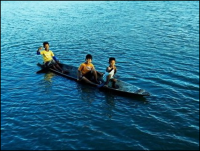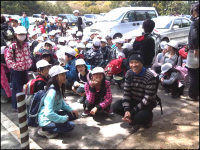It is my great and humble honour to have this opportunity to share with all of you some reflections that come from my research, teaching and social life experiences inspired by the urgent need to not forget those who are forced to live in abject poverty, deprivation, persecution, global racism and patriarchy as well as imperial interventions and other forms of organized violence. I express my deep thanks to the organizing committee of the SYLFF Asia/Pacific Regional Forum. It feels very good to be amongst many people with different accents for after all, all accents are beautiful. They reflect a tiny part of the great human, social, cultural and ecological heterogeneity of humanity and the planet.
Let me begin my address today by saying that one of the greatest ironies of our times is that human rights have become very much the language of progressive politics around the globe as well as a powerful tool to justify increased weaponization, militarization, global racial profiling and war amidst unprecedented levels of poverty and social inequality, and unprecedented levels of the accumulation of wealth in fewer hands, both locally and globally. This is happening at times when patriarchal ideological practices are being transformed but not disappearing. Nowadays, global patriarchy under the excuse of protecting women, children and national securities is becoming a mask to invade other countries and to curtail fundamental social justice gains in the global north as well as in the global south. As the late Iris Young, a feminist political philosopher from the United States, convincingly demonstrated, patriarchy is being renovated as part and parcel of the logic of masculinist protection that helps account for the rationale leaders give for deepening a security state and its acceptance by those living under their rule (2007: 133). Young’s analysis, however, is not incorporated in the vast field of human rights mainstreaming discursive practice. This regime has established, as a hegemonic truth, the idea that formal legal equality means concrete equality when in fact the ideology of formal equality has co-existed with colonialism, slavery, patriarchy and heterosexism, and with a globally skewed distribution of wealth and income. The recognition of the co-existence of power and wealth in fewer hands, fiercely protected by the rule of law—including through the use of sanctioned organized violence alongside abject poverty—is an urgent call to rethink human rights in a world of increased inequalities together with the proliferation of different forms of violence. Scholar Shelley Wright has offered some important reflections on the paradoxes of power inequality and its main beneficiaries. It is appropriate, therefore, to quote her at length for she points out that, "Economic and social redistribution through industrialization and globalization can also create conditions conducive to violence. The globalization of a Euro-American economic model may have created conditions for peace and prosperity for Western Europe and its former white settler colonies such as the United States, Canada and Australia, but it has not necessarily resulted in such benefits for the rest of the world" (Chowdhury 1995; Cowen and Shelton 1996; Escobar 1995; Rajagopal 2000; Seabrook 1993; Wright 2000).
The effects of unrestrained trade liberalization have given rise to serious levels of violence from the wars over resource industries in Liberia, Sierra Leone, the Congo and Angola (diamonds, gold, copper) to the infliction of intolerable working conditions on people in factories throughout the developing world. The fragmentation and civil war in Yugoslavia can be directly traced to severe economic policies imposed by the IMF and other international economic institutions in the 1980s (Orford 1997). Expropriation of land for the development of cash-crop agriculture has increased the flow of people into urban centres, disrupting traditional economic patterns, community life and political stability, leading to high levels of state-sanctioned violence, workplace harassment, assaults and killings (Waring 1996) [2005: 161].
The imperial logic of masculinist protection, supported by many women, as Iris Young notes (2007), is fundamental in understanding the today’s world-wide increased inequalities for it positions leaders, along with some other officials such as soldiers and firefighters, as protectors, and the rest of us in the subordinated position of dependent, protected people (2007:133).
Patriarchal militarism however, is not new. It was part of direct colonial ruling since the end of the 15th century through the conquest of the Americas. Along with race as a powerful tool of social classification and the appropriation of labour and material resources (Quijano 2000), military patriarchy is part of what legal scholar Anthony Anghie calls the civilizing mission, the grand project that has justified colonialism as a means of redeeming the backward, aberrant, violent, oppressed, undeveloped people of the non-European world by incorporating them into the universal civilization of Europe (2005).
This civilizing mission, Anghie adds, was based on the idea that fundamental cultural difference divided the European and non-European worlds in a number of ways. For example, the characterization of non-European societies as backward and primitive legitimized European conquest of these societies and justified the measures colonial powers used to control and transform them (2005:3).
Sociologist Anibal Quijano notes that the civilizing mission, although officially closed, has endured the life of direct colonial ruling. It informs the current global modern colonial system of power (2000). The civilizing mission mentality feeds today’s common idea that the global north is the inventor of human rights and of their respect and promotion, and the global south is the prototype of a human violator because it still is trapped in pre-modernity. This mentality means, in other words, that “Third World” peoples are incapable of creating liberating knowledge that can serve the entire humanity, especially women, indigenous people and those forced to live in poverty. Under this mentality, “First World” people are inherently invested with “superior qualities,” a binary that only helps the already privileged both in the global north and the global south. This binary culturalizes fundamental demands for social justice. Culturalization is a process that describes “an exclusive focus on culture, understood as frozen in time and separate from systems of domination” (Razack 2004:131).
Challenging this mentality in the field of human rights is extremely important to counteract the all too easy assumption that the global south is the receptor of human rights knowledge whose epicenter is the global north. The term “human rights” may have been coined in non-western spaces but the knowledge and practice of what is just and unjust, individually and collectively is not the private property of certain people or geography. Indeed, knowledge on social and cultural justice has existed both as philosophies and practices in many ancient and heterogeneous civilizations, including, of course, those that flourish in Europe.
Rethinking human rights would mean being able to recognize that in the name of human rights, democracy, prosperity and freedom, terrible crimes and inequities have been perpetuated. As Singer points out, “When we ask ourselves whether a social or legal practice works, we must ask ourselves, ‘works for whom?’ Who benefits and who loses from existing political, economic, and legal structures?” (1990:1841 quoted in Nyamu Musembi, 2005: 32). Such an approach acknowledges the concreteness of unequal power relations within and between nations as well as the existence of hierarchical relationships between the global South and the North. Consequently, we cannot bypass these asymmetries in order to paint a conveniently nice picture of abstract inclusivity. Nevertheless, conventional theories and policies dealing with transnational issues locate these asymmetries as part of the so-called “clash of civilizations,” which is another way of saying that socio-economic and political exclusions do not have anything to do with the shape of our world today for it is the “culture of the other” and his/her “inherent violent un-civilization” that are the problems.
Canadian feminist scholar Sherene Razack notes that there is a revival of the logic that there is an irreconcilable clash between the West and the rest of the world (2004), under which the West is a defender and promoter of human rights and the rest of the world is a violator of human rights. Because “the rest” is overtly patriarchal and uncivilized, therefore unfit to democracy and to the creation of innovative knowledge (Ibid).
Why are these insights not influencing the mainstream world of human rights expertise? It would be extremely difficult to pinpoint a correct response. However, one of the reasons for this purposeful oblivion may be the human rights regime as it helps maintain the illusion that it is possible to escape the general consequences of social inequalities locally and globally by immersing ourselves in the world of abstract equality and the rule of law even when there is countless information that says otherwise. For instance, the United Nations reported in 2003 that there were more than a billion people living in poverty. Numbers alone do not say much but if for an instant we try to imagine ourselves with no food, no shelter and being harassed and persecuted, we then may change our approach to cold numbers about poverty and empty discourse on the rule of law and formal equality as representing human rights. While many do not have to think about the availability of food for their next meal or of a roof over their heads alongside their entitlement to their cultural identities and the inherent respect because they are women, disabled, etc., the majority in the world still demand the foundational right to have rights. And this, dear audience, is a fundamental difference between human rights as theory and human rights as practice.
Legal formal equality, as important as it is, is simply insufficient to reduce poverty, unemployment, racism, and violence because whether human rights experts like it or not systemic oppressions are interconnected and they are lived by millions on this planet. We have sufficient research that demonstrates this fact but we also have research that demonstrates the opposite. Therefore to say that we are defending and promoting human rights is not implicitly just. We need to ask unpopular questions to come up with new and more honest ways to bring about social and cultural justice. We need to ask whose human rights are more protected and whose human rights are ignored and denied. Moreover, these are poignant issues about leadership understood broadly and not as the property of politicians and privileged people.
Long ago diverse grass roots social movements in the global south and many in the global north demonstrated the incongruities of an abstract and universalistic doctrine of human rights in the face of gruesome economic exclusion, political persecution under state terror and the spreading of violence against women. Critical scholars, such as Frantz Fanon also observed long ago that forcing people to live in poverty, to lack education and to daily encounter humiliation based on race, ethnicity, culture, language, and religion are intertwined realities, which at the end, dehumanize entire populations. Brilliantly he reflected that the damnés cannot go to hell for they are already in hell (in Maldonado-Torres 2006). Therefore, to assume that human rights are by de facto at the service of the human condition is not only naïve but dangerous for it is not all humans’ humanity that is included in this assertion but the humanity of some at the expense of the humanity of the majority.
Poverty, imperial wars and its daily and deadly impacts, I am afraid, are dehumanizing all of us because they are becoming a “normal” part of life and when something as deadly as poverty, state terror and war become so obviously “natural” we can continue saying that we support equality and the dignity of all humans and in fact contributing to and perpetuating the hierarchy of humanity in which some humans count as humans, some lives count as lives and some deaths deserve to be grieved.
As part of my urgent call to rethink human rights is the invitation to reflect about the ideological practice to represent persecuted, impoverished and victimized peoples as passive victims in need of salvation for it has serious implications such as indirectly feeding the dichotomy of “deserving and undeserving victims of human rights violations,” where “deserving victims” are thought and treated as “truly innocent and apolitical,” and “undeserving victims” as “partisans, collaborators and even terrorists.” My research as well as others’ attests to this fact (Martinez 2000, 2002, 2005; Grandin 2004, 2006; Jonas 1991, 2000; Razack 2004). Victimized people are survivors who have not created systemic violations of human rights. Feeding the industry of victimology even with the best intentions is not wise leadership; it is the continuation of colonial paternalism and maternalism at best, and indirect and direct racism and Orientalism, at worst.
Paternalistic and maternalistic victimization is dangerous because as soon as political conditions change as it has happened after the tragedy of September 11, 2001, the other face of victimization surfaces: the vilification and demonization of peoples and cultures as threats to the nation, to progress, and to human rights to the point that many men and women legally lose the little humanity attached to their bodies, minds and spirits. They become disposable or “bare life” (Homo Sacer) in Agamben’s terms (1998). In either case, the inferiorized “Other” is seen as lacking creativity to create knowledge and lacking ability to be a progressive actor that dreams of the possibility of another just world.
Keeping in mind the urgency to rethink human rights in a world of increased inequalities and to decolonize and de-victimize survivors and community leaders as a relevant step towards the creation of a new leadership in human rights, I would like to invite you to watch a short video that demonstrates part of the effects of transnational corporate mining in Guatemala, an economic activity portrayed as a good development strategy for a society torn by four decades of state terror during which more than 200,000 people were killed, 83% of which were indigenous people and the rest Mestizo men and women who struggled in practice for an integral vision and practice of human rights (CEH 1999). The video titled “Violent Evictions At El Estor, Izabal, Guatemala” shows how,
"On January 8th and 9th 2007, hundreds of police and soldiers in Guatemala forcibly evicted the inhabitants of several communities who were living on lands that a Guatemalan military government had granted to Canadian mining company INCO in 1965. Local indigenous populations claim the land to be theirs, and resent the exploitation of an outside corporation. Canada’s Skye Resources now lays claim to the land, and paid workers a nominal sum to destroy people’s homes. With the force of the army and police, company workers took chainsaws and torches to people’s homes, while women and children stood by. Skye Resources claims that they maintained 'a peaceful atmosphere during this action' (Rights Action 2007)." This video is available at http://www.rightsaction.org.
References
-
- Agamben, Giorgio. 1998. Homo Sacer: Sovereign Power and Bare Life. Standford: Standford University Press.
-
- Anghie, Antony. 2005. Imperialism, Sovereignty and the Making of International Law. Cambridge University Press.
-
- Comisión del Esclarecimiento Histórico -CEH-. 1999. Guatemala Memory of Silence TZ'INIL NA'TAB'AL. Report of the Commission for Historical Clarification. Guatemala. CD Spanish Electronic version.
-
- Grandin, Greg. 2006. Empire’s Workshop. Latin America, The United State, And The Rise of the New Imperialism. New York: Metropolitan Books.
-
- Grandin, Greg. 2004. The Last Colonial Massacre. Latin American in the Cold War. Chicago and London: The University of Chicago Press.
-
- Jonas, Sussane. 2000. Of Centaurs and Doves. Guatemala's Peace Process. Boulder, Colorado: Westview Press.
-
- Jonas, Sussane. 1991. The Battle for Guatemala: Rebels, Dead Squads, and U.S. Power. Boulder, Colorado: Westview, Press.
-
- Maldonado-Torres, Nelson. 2006. The Time of History, the Times of Gods, and the Damnés de la terre. Worlds & Knowledges.
-
- Martínez Salazar, Egla J. 2005. The Everyday Praxis of Guatemalan Maya Women: Confronting Marginalization, Racism and Contested Citizenship. Doctoral Dissertation, York University, Canada. Unpublished Manuscript.
-
- Martínez, Egla J. 2002/2003. Peace as a Masquerade: Militarization and Post-War Terror in Guatemala. Canadian Woman Studies. Volume 22, Number 2. Pp. 40-46.
-
- Martínez-Salazar, Egla. 2001. "Development and coercion in the Maya-Tzutuhil community of Santiago Atitlán, Guatemala." In Desfor, Gene, Deborah Barndt & Barbara Rahder Eds. Just Doing It: Popular collective action in the Americas. Montreal, New York & London: Black Rose Books.
- Nyamu-Musembi, Celestine. 2005. “Towards an actor-oriented perspective on human rights.” In Kabeer, Naila, Editor, Inclusive Citizenship. Meanings and Expressions. London & New York: Zed Books.
-
- Quijano, Anibal. 2000. Coloniality of Power, Eurocentrism, and Latin America. Nepantla: Views from South, 1.3
-
- Razack, Sherene. 2004. Imperilled Muslim Women, Dangerous Muslim Men, and Civilised Europeans: Legal and Social Responses to Forced Marriages. Feminist Legal Studies 12.
-
- Rights Action. 2005. Skye Resources to buy Exmibal properties and legacy in Guatemala. Info@rightsaction.org/
-
- Rights Action. 2007. News and Reports on Human Rights in Guatemala. http://www.rightsaction.org (Accessed on November 16 and December 26, 2007).
-
- Wright, Shelley. 2001. International human rights, decolonization and globalization: becoming human. London/New York: Routledge.
-
- Young, Iris. 2007, Global Challenges. War, Self-Determination and Responsibility for Justice. Cambridge, UK: Polity.









